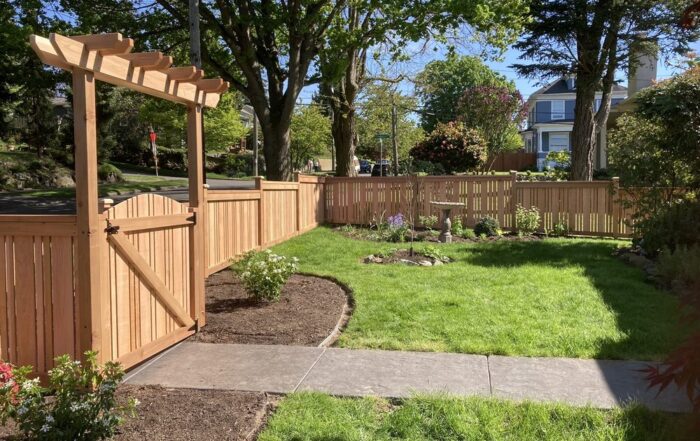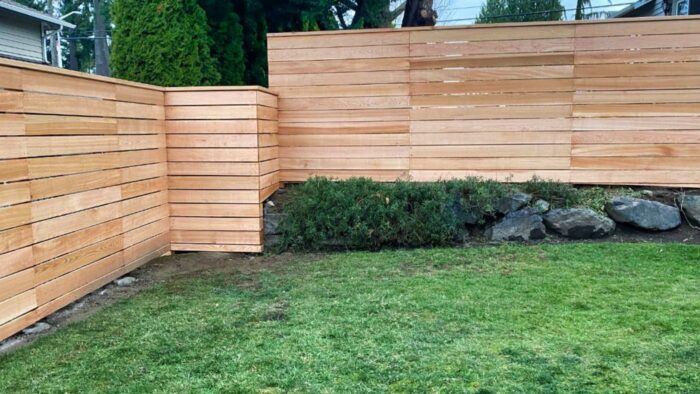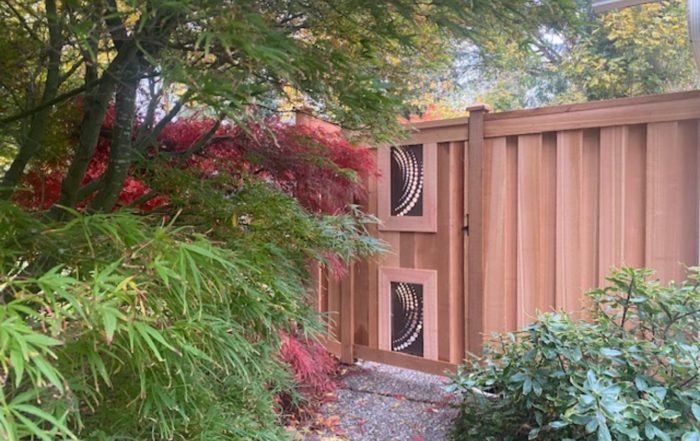Learn how to build a soundproof fence to reduce noise from traffic or neighbors, using the best materials and techniques.
Need to block out noise from traffic or neighbors? A soundproof fence can help. This article explains how to build a fence that reduces unwanted noise, choose the right materials, and enhance your outdoor space.
Key Takeaways
- Soundproof fences effectively block unwanted noise from sources like traffic and loud neighbors, creating a serene outdoor space for relaxation.
- Choosing the right materials, such as heavy wood, brick, or mass-loaded vinyl, and ensuring an airtight installation are key for maximizing noise reduction.
- Regular maintenance, including inspections and weather protection, is essential for maintaining the effectiveness and longevity of your soundproof fence.
Understanding Soundproof Fences
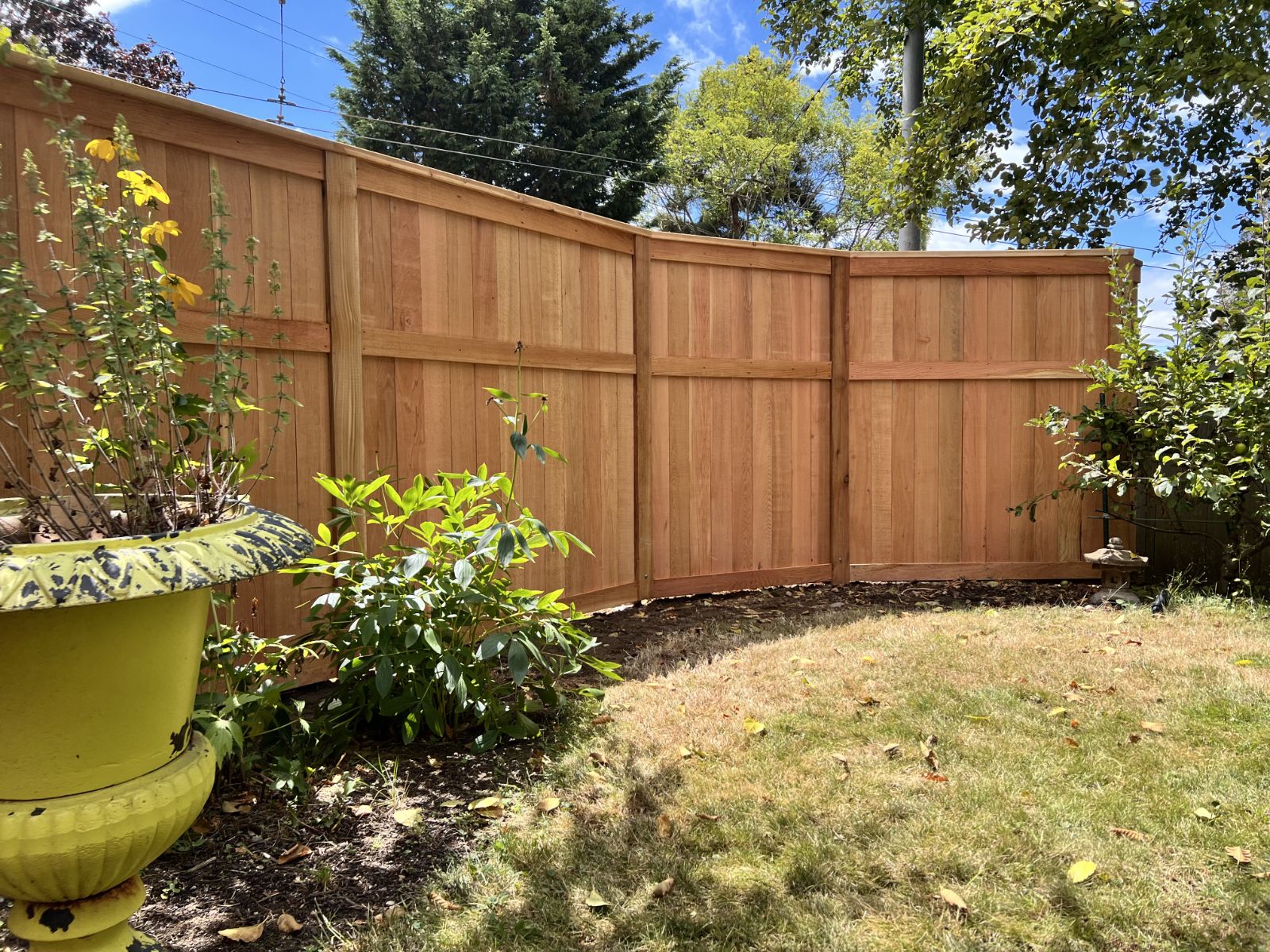
Noise-dampening fence built by Sky Fence Company in Seattle’s Fremont neighborhood.
Soundproof fences are designed to create a quieter and more comfortable environment by acting as effective sound barriers. They are particularly beneficial for blocking traffic noise, loud neighbors, and other disruptive sounds. These fences are not just for homes but are also used by businesses to contain noise from machinery and processes that could disturb neighbors.
The primary goal of a soundproof fence is to reduce stress and anxiety caused by noise pollution, which can lead to health issues such as sleep disturbances and hearing loss. By blocking unwanted noise, soundproof fences help create a serene outdoor space for relaxation and enjoyment.
How Soundproofing Works
Soundproof fences work primarily by blocking airborne noise. Solid objects, like soundproof fences, hinder the passage of sound waves, making them effective barriers. The key to effective soundproofing is mass; the more massive the barrier, the better it can block external noise. This is why adding mass-loaded vinyl or other heavy materials to a fence significantly improves its noise reduction capabilities.
Think of soundproofing like sealing leftovers in Tupperware. Just as Tupperware contains air and prevents it from escaping, sound barriers contain and block sound waves.
Common residential noise sources include traffic, noisy neighbors, and mechanical equipment like HVAC units. Understanding how soundproofing works helps you appreciate the importance of using the right materials and techniques to block unwanted noise effectively.
Benefits of Soundproof Fences
Installing soundproof fences offers numerous benefits beyond just noise reduction. These fences can significantly enhance the privacy and security of your property, creating a more peaceful and enjoyable outdoor space. Additionally, soundproof fences can increase the aesthetic appeal and functional value of your property, potentially leading to a higher property value.
With a soundproof fence, you can block unwanted noises and enjoy the desirable sounds of nature, like birds chirping and leaves rustling. This creates a more pleasant and serene environment, allowing you to fully enjoy your outdoor space without the intrusion of less desirable noises.
Whether you’re dealing with traffic noise or noisy neighbors, a soundproof fence can make a significant difference in the quality of your outdoor living experience.
Assessing Your Noise Problem
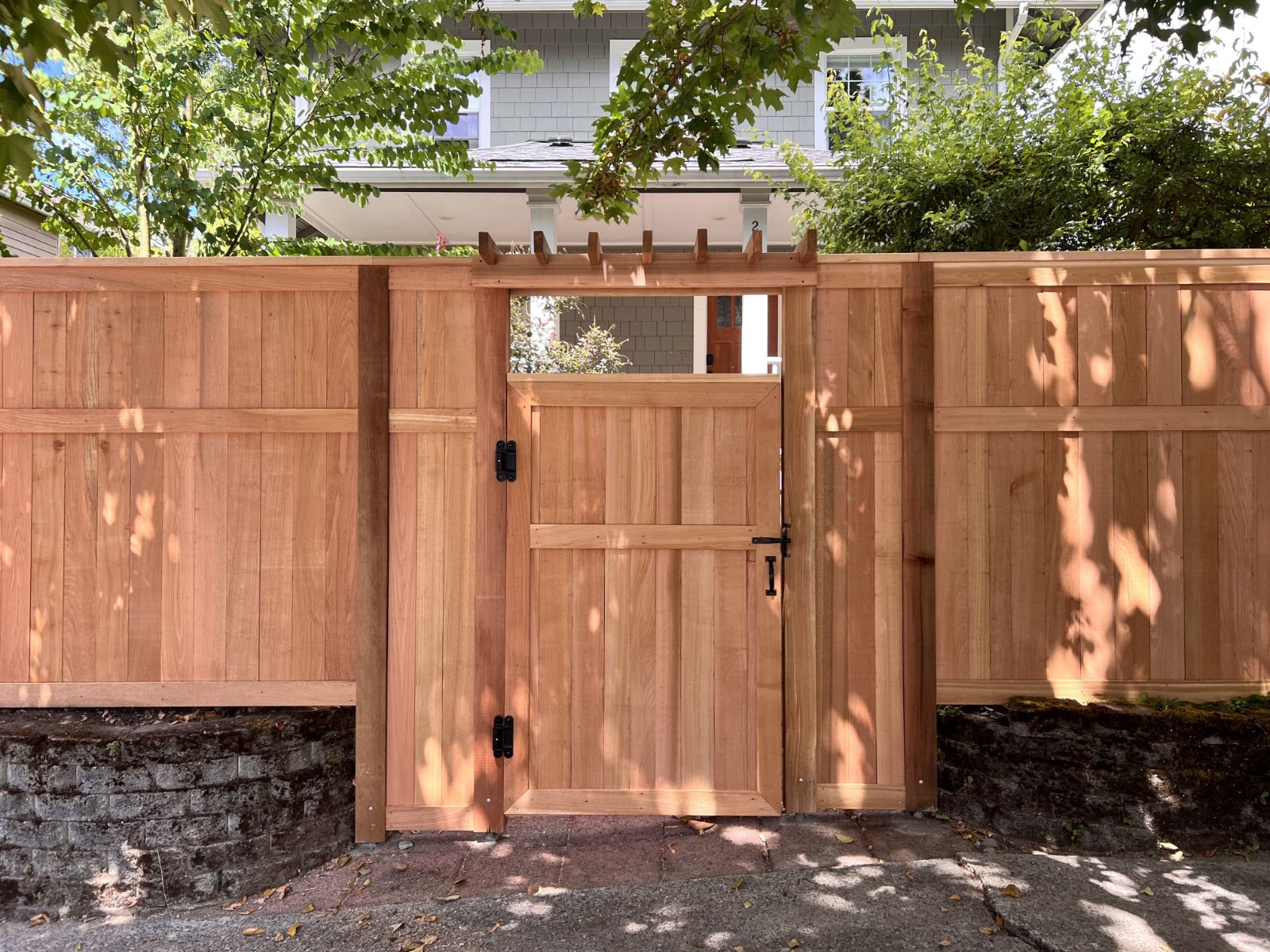
Sky Fence Company built this cedar wood fence in Seattle, WA, using oversized posts to support the added weight of the soundproofing material and gate.
Before you start building a soundproof fence, it’s crucial to assess the noise problem you’re facing. Understanding the extent and sources of noise will help you plan an effective noise barrier fence. This process involves measuring noise levels and identifying the specific noise sources that disrupt your peace. Whether it’s traffic noise, noisy neighbors, or other unwanted noise, assessing the problem is the first step towards a solution.
Locations that might require a sound barrier fence include residential areas, pickleball courts, and construction sites. It’s also essential to check local regulations and HOA guidelines before constructing a soundproof fence to ensure compliance with any rules or restrictions. By thoroughly assessing your noise problem, you can tailor your soundproofing efforts to achieve the best possible results.
Measuring Noise Levels
Measuring noise levels is an essential step in understanding the extent of your noise problem. You can measure the noise levels around your property using a smartphone app. Alternatively, a sound meter can also be effective for this purpose. Decibels (dB) are used to measure noise. This unit quantifies the intensity of sound. Normal conversation typically measures around 60 dB. In contrast, traffic noise ranges from 70 to 90 dB.
Online maps and websites can provide information about average noise levels in various areas. You can check them for specific details. Measuring noise levels helps identify the most affected areas of your property, allowing you to plan your soundproofing efforts accordingly. This information is crucial for determining the effectiveness of your noise barrier fence and ensuring it provides the desired noise reduction.
Identifying Noise Sources
Before:
Identifying the specific sources of noise is crucial for effective soundproofing. Common noise sources include traffic noise, noisy neighbors, and machinery like HVAC units, pool pumps, and generators. Understanding where the noise is coming from helps you plan the placement and design of your soundproof fence to block noise effectively.
After:
Common noise sources include:
- Traffic noise
- Noisy neighbors
- Machinery like HVAC units
- Pool pumps
- Generators
Understanding where the noise is coming from helps you plan the placement and design of your soundproof fence to block noise effectively.
Online resources can provide information about average noise levels in specific areas and neighborhoods, aiding in the assessment process. Identifying noise sources and levels allows for better planning of soundproof fence construction to maximize noise reduction effectiveness.
This targeted approach ensures that your soundproofing efforts address the most significant noise issues, creating a more peaceful outdoor environment.
Choosing the Right Materials for Soundproofing
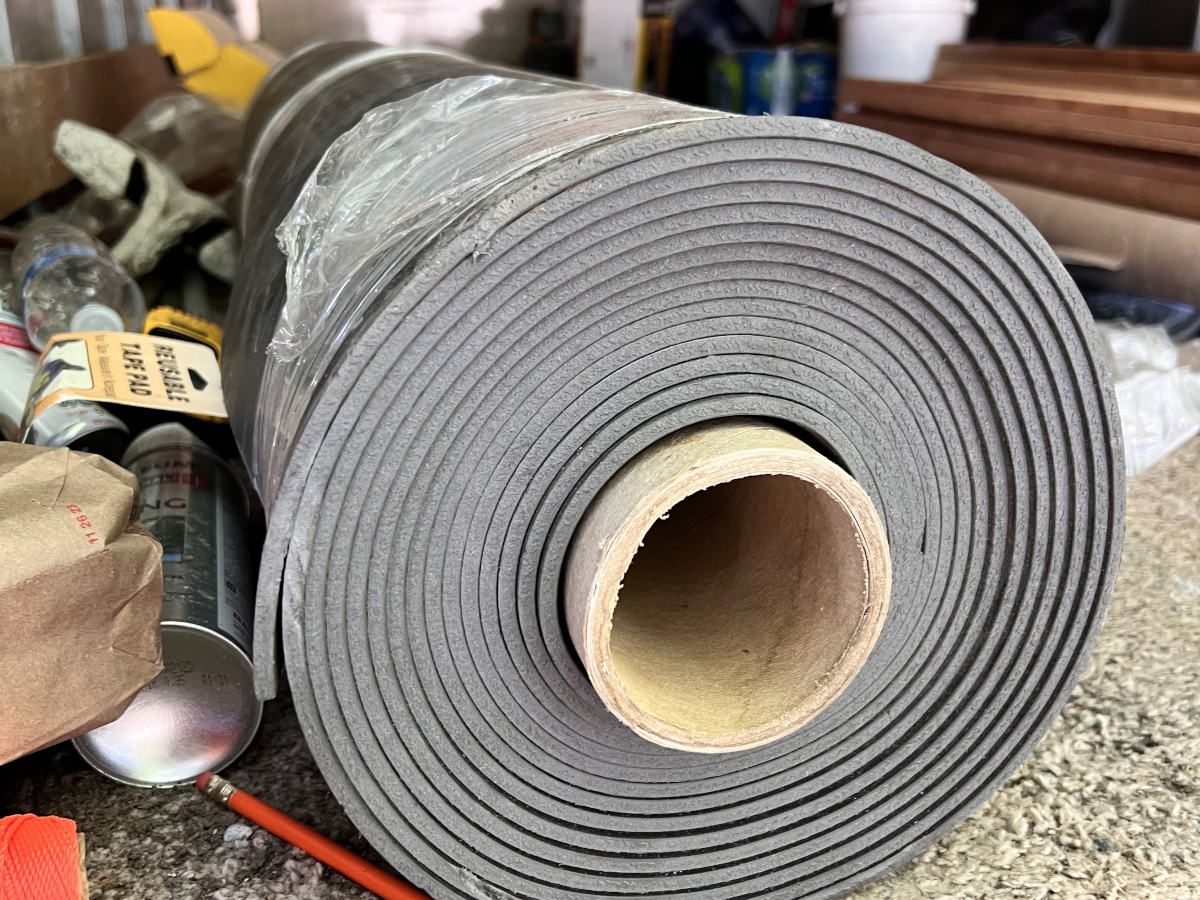
Roll of heavyweight Mass Loaded Vinyl (MLV) used for noise dampening.
Choosing the right materials is crucial for creating an effective soundproof fence that significantly reduces noise. Heavier or denser materials like cedar wood and brick are particularly effective at blocking sound waves. Increasing the mass of a surface enhances its ability to block sound waves, making it an essential factor in soundproofing.
Common soundproofing materials include mass-loaded vinyl, acoustic foam, and fiberglass insulation. These materials can be used in various combinations to create a sound barrier fence that effectively blocks unwanted noise.
Installation techniques also play a significant role in soundproofing effectiveness, making careful placement and attachment important.
Mass Loaded Vinyl (MLV)
Mass Loaded Vinyl (MLV) is a heavy and flexible material that is highly effective at blocking sound waves. Adding MLV to a fence increases its mass, thereby improving its noise-blocking capabilities. MLV can be easily applied by attaching it to the fence using staples or glue, ensuring that the entire surface is covered with no gaps or overlaps.
When applying MLV, it’s essential to overlap the sheets and caulk seams for a solid barrier. This material can also be added to existing fences to enhance their soundproofing capabilities. Incorporating MLV can significantly enhance the noise reduction performance of your soundproof fence.
Acoustic Fence Panels
Acoustic fence panels are another highly effective soundproofing material. Products like Echo Barrier and Acoustic Fence Wrap can provide significant noise reduction, potentially reducing noise levels by up to 70%. These panels are designed to absorb and block sound waves, making them an excellent option for soundproof fences.
Installing acoustic fence panels is relatively straightforward and involves attaching them to the fence using nails or screws. Ensuring that the panels are flush with no gaps is crucial for maximizing their noise reduction potential.
Acoustic fence panels can be used on both new and existing fences to enhance their soundproofing capabilities.
Dense Vegetation and Landscaping
Incorporating dense vegetation and landscaping elements can also contribute to soundproofing. Trees, shrubs, and other dense vegetation can act as natural barriers, helping to absorb and diffuse sound waves. Landscaping with dense vegetation can create a more aesthetically pleasing environment while also reducing noise levels.
Using landscaping elements strategically can enhance the effectiveness of your soundproof fence. Planting trees and shrubs along the fence line adds an extra layer of noise reduction, complementing the fence’s soundproofing capabilities. This approach not only improves soundproofing but also enhances the overall appearance of your outdoor space.
Building a New Soundproof Fence
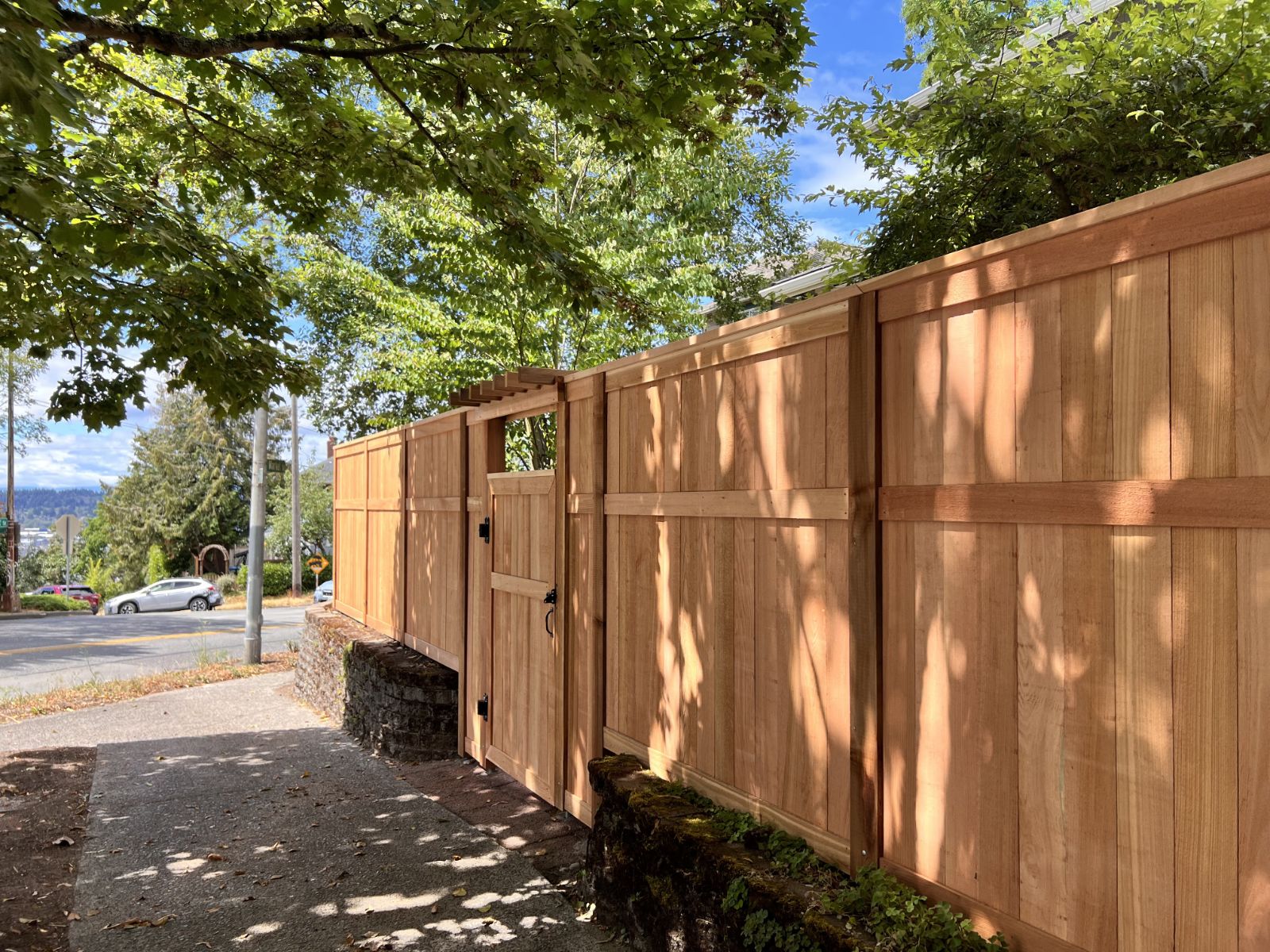
Sky Fence Company built this cedar wood fence in Seattle, WA, using oversized posts to support the added weight of the soundproofing material and gate.
Building a new soundproof fence from scratch allows you to incorporate all the necessary soundproofing elements for maximum effectiveness. The first step in this process is planning the layout and choosing the right materials. If an existing fence is not adequate for soundproofing, constructing a new fence with the appropriate height and placement is advisable.
Increasing the mass and making the fence airtight can significantly enhance its soundproofing capabilities. Adding multiple layers of soundproofing materials and incorporating additional sound-absorbing elements can further improve the fence’s ability to block noise.
Following these steps allows you to build a new soundproof fence that effectively reduces unwanted noise.
Planning and Layout
The location of a soundproof fence is crucial as it significantly affects its effectiveness in blocking sound waves. Placing sound barriers closer to the noise source enhances their effectiveness. The first step in installing a noise barrier fence is preparing the ground and layout, using stakes and strings to mark the fence area.
A sound barrier should ideally be four times the distance from the noise source or receiver for optimal effectiveness. Utilizing the line of sight rule aids in the strategic placement of sound barriers. Mass Loaded Vinyl is most effective when applied during the initial construction of a fence. Careful planning of the layout ensures that your soundproof fence provides maximum noise reduction.
Installing Posts and Panels

Sky Fence Company installing fence posts along the property line on a busy street to frame a new soundproof fence.
Installing posts and panels is a critical step in building a soundproof fence. Start by placing posts in holes and filling them with concrete or gravel to ensure stability. The post holes should be about 2 feet deep for proper installation. Once the posts are in place, attach acoustic fence panels using nails or screws, ensuring they are flush with no gaps.
To ensure stability, keep a distance of at least 50mm from the edges when screwing the panels. This method provides a secure and stable structure that effectively blocks noise. Following these installation steps ensures that your soundproof fence is both sturdy and effective in reducing noise levels.
Adding Soundproofing Elements
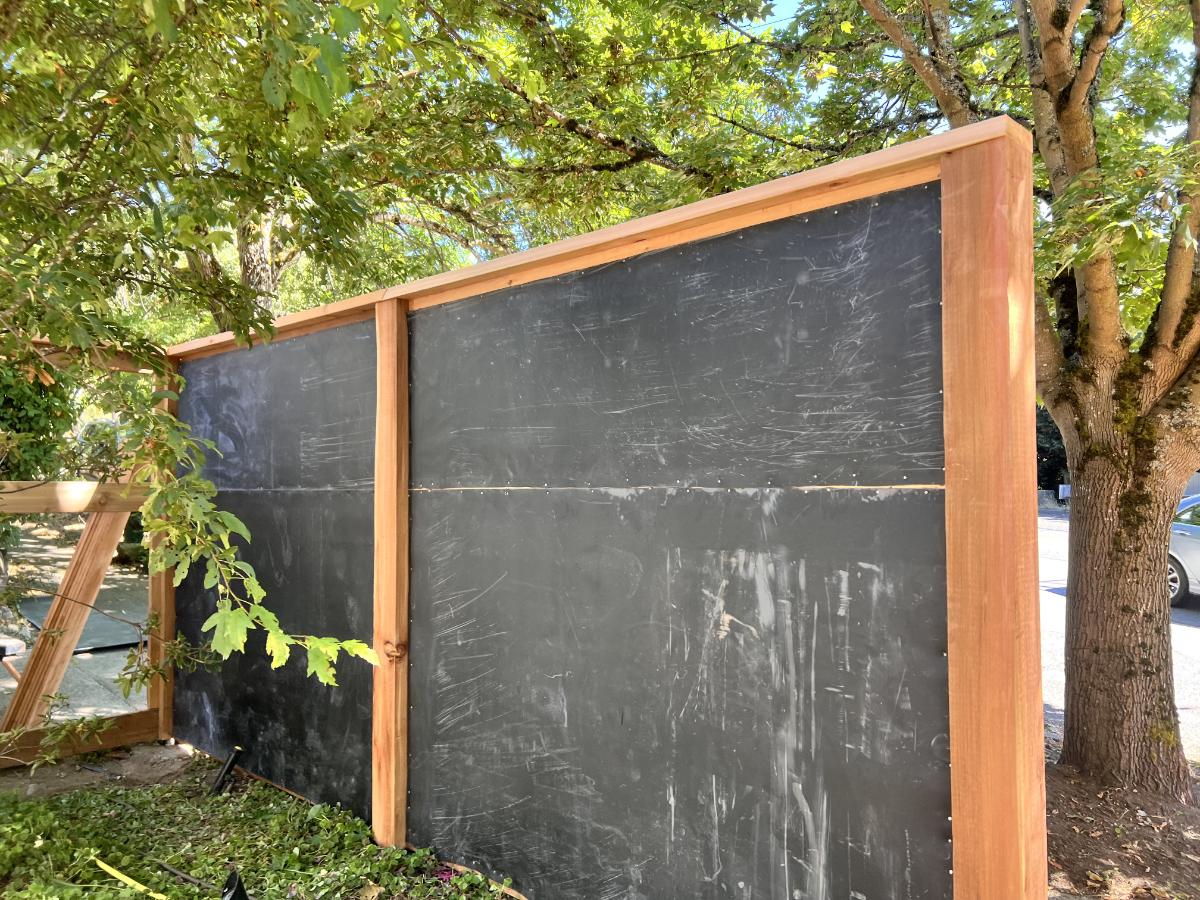
MLV is sandwiched between two layers of cedar wood boards for added noise dampening.
Incorporating multiple layers of soundproofing materials can greatly enhance a fence’s ability to block noise. Adding more layers significantly improves soundproofing effectiveness by increasing the mass and density of the barrier. Covering any gaps with acoustic materials is crucial to prevent sound leakage and improve overall noise reduction.
To maximize sound blocking in fence construction, it is critical to have no gaps and create an airtight barrier. This ensures that sound waves are effectively blocked and reflected away from the desired area, creating a quieter and more peaceful outdoor environment.
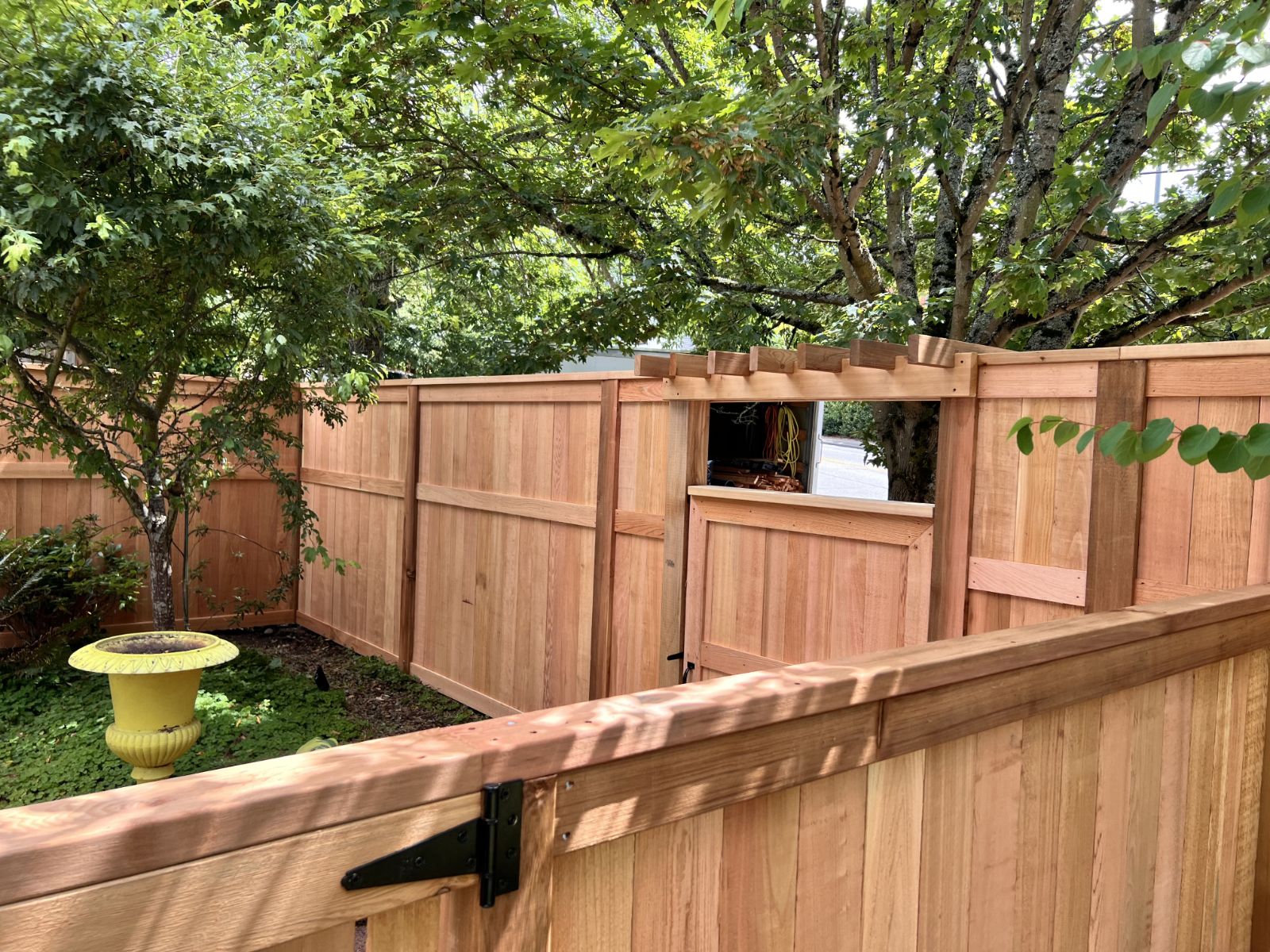
Once the second layer of cedar boards is installed over the MLV and the rest of the fence is framed in, it will have a sleek, professional appearance with the added benefit of superior noise protection from traffic.
Enhancing Existing Fences for Soundproofing
Enhancing an existing fence for soundproofing involves increasing its density, adding sound absorption materials, and ensuring it is well-sealed. By focusing on these areas, you can significantly improve the noise reduction capabilities of your existing fence.
Adding sound absorption materials, such as acoustic panels or dense vegetation, can help diminish reverberations and echo near the fence. Sealing gaps and overlaps is crucial to prevent sound leakage and enhance the overall sound dampening effectiveness of the fence.
Reinforcing with Mass Loaded Vinyl
One effective way to enhance the soundproofing capabilities of an existing fence is by reinforcing it with Mass Loaded Vinyl (MLV). MLV is a flexible, heavy material that adds mass to the fence, thereby improving its ability to block sound waves.
To install MLV, attach it to the fence using staples or glue, ensuring complete coverage with no gaps or overlaps. Adding more mass and sealing seams with caulk creates a solid barrier that significantly reduces noise transmission.
Sealing Gaps
Sealing gaps in your soundproof fence is essential for preventing sound leakage. Any unsealed gaps can significantly reduce the effectiveness of the fence, allowing sound to penetrate and escape.
Covering gaps with acoustic materials helps improve the noise-blocking capabilities of your fence, leading to greater privacy and tranquility. Ensuring that the fence is airtight, with no gaps or overlaps, is crucial for maximizing its soundproofing effectiveness.
Increasing Fence Height
Raising the height of a fence can significantly block sound and enhance privacy. A higher fence creates a more effective sound barrier by blocking the line of sight to noise sources, thus reducing noise levels.
For optimal noise reduction, a fence should be at least 50% higher than the structure producing the noise. Each additional foot of fence height above the line of sight can achieve approximately 0.5 dB further noise reduction. Checking local regulations is crucial. They often contain restrictions on the height of fences.
Additional Soundproofing Measures
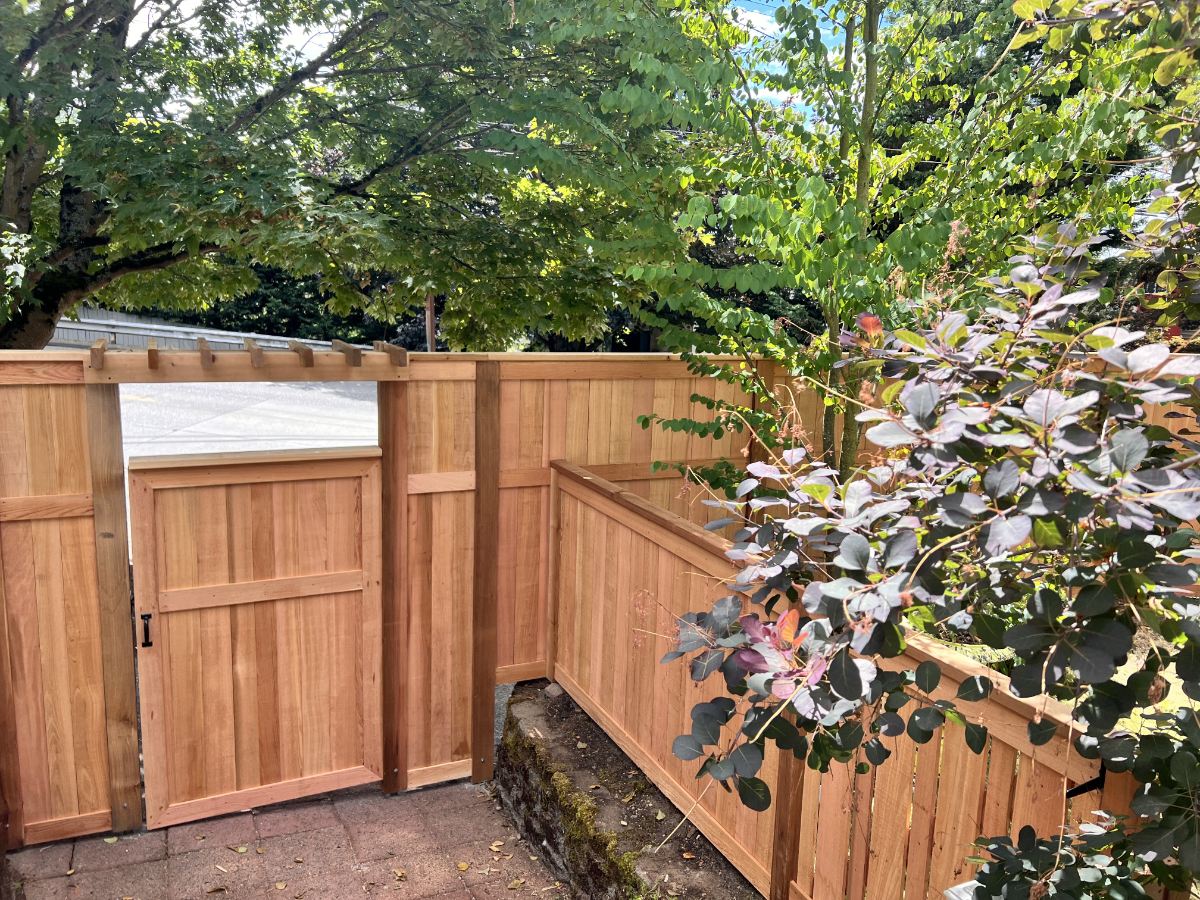
Proper placement relative to the street, along with the surrounding trees and shrubs, will provide additional noise protection.
In addition to constructing a soundproof fence, there are several other measures you can take to reduce noise in your outdoor space. Combining methods, such as using landscaping elements and regular maintenance, can enhance the effectiveness of your soundproofing efforts.
Incorporating additional measures creates a more serene and tranquil environment. Regular cleaning and applying protective sealants help maintain the effectiveness of your soundproof fence over time.
White Noise Machines
White noise machines are an effective tool for masking background noise. These machines produce a constant ambient sound that blends into existing noise, creating a more tranquil environment.
While white noise machines are not a complete alternative for soundproofing, they can complement your soundproof fence by masking less desirable noises. This combination creates a more peaceful outdoor space where you can relax and enjoy your surroundings.
Water Features and Wind Chimes
Installing water features, such as fountains, can contribute to sound masking by providing a pleasing background noise. These features create soothing sounds that help distract from unpleasant noise pollution, enhancing the serenity of your outdoor space.
Wind chimes also serve to create pleasant, relaxing sounds that can help mask unwanted noise. By incorporating water features and wind chimes into your landscaping, you can create a more tranquil and enjoyable environment.
Maintenance Tips for Longevity

This beautiful, newly completed soundproof fence from Sky Fence Company is ready for a coat of stain to protect it from the Seattle weather.
Regular maintenance is crucial for ensuring the longevity and effectiveness of your soundproof fence. Regular inspections help identify potential damage early, allowing you to address issues before they worsen.
Protecting your fence from adverse weather conditions by applying waterproof sealants or stains can prolong its lifespan. Regular cleaning helps remove debris that may cause damage over time, ensuring that your soundproof fence remains sturdy and effective.
Regular Inspections
During regular inspections, check for cracks, holes, loose nails, sagging panels, and damage to mass-loaded vinyl or acoustic foam. Look for signs of fading or loose panels, and repair any damage immediately to prevent further deterioration.
Regular inspections are essential for maintaining the effectiveness and prolonging the lifespan of your soundproof fence. By addressing issues early, you can ensure that your fence continues to provide optimal noise reduction and privacy.
Weather Protection
Applying a waterproof sealant or stain to your fence panels can protect them from weather elements, ensuring they remain effective against noise. Covering mass-loaded vinyl and acoustic foam with weather-resistant fabric or material adds an extra layer of protection.
Positioning sprinklers away from the fence can prevent water damage, while regular cleaning helps remove debris that may cause damage over time. These measures ensure that your soundproof fence remains durable and effective in reducing noise levels.
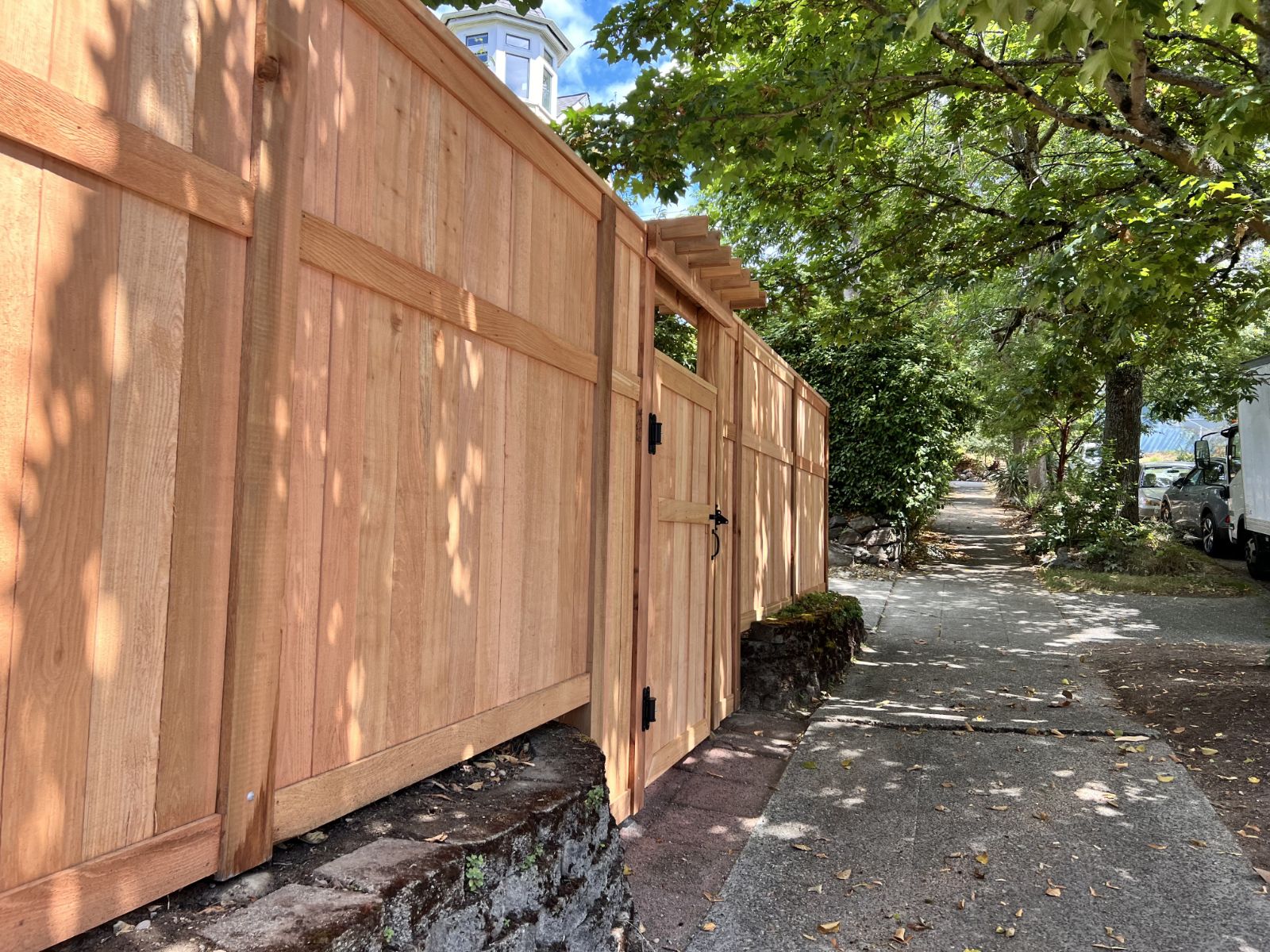
This completed project in the Fremont neighborhood of Seattle, Washington, by Sky Fence Company, uses premium cedar wood boards to provide privacy and noise reduction.
Summary
Building a soundproof fence is a practical solution for reducing unwanted noise and creating a quieter, more peaceful outdoor space. By understanding how soundproofing works, choosing the right materials, and incorporating additional soundproofing measures, you can significantly improve the tranquility of your property.
Regular maintenance and inspections are crucial for ensuring the longevity and effectiveness of your soundproof fence. By following the tips and techniques outlined in this guide, you can create a serene environment where you can relax and enjoy your outdoor space without the intrusion of unwanted noise.
Frequently Asked Questions
What materials are best for soundproofing a fence?
To effectively soundproof a fence, use heavier and denser materials like wood, brick, or mass-loaded vinyl. These materials will do a great job at blocking sound waves and keeping your space quieter.
Can I add soundproofing materials to an existing fence?
Absolutely, you can boost your existing fence’s soundproofing by adding mass-loaded vinyl and acoustic panels while sealing any gaps. It’s a simple way to create a quieter outdoor space!
How high should a soundproof fence be?
To effectively reduce noise, aim for a soundproof fence that’s at least 50% taller than the noise source. Adding more height can provide extra noise reduction benefits.
Keep in mind that Washington State requires a permit for fences over 6 feet tall. You may also have neighbors to consider, so it’s essential to discuss your plans with them to ensure mutual agreement and compliance with local regulations.
Are white noise machines effective for outdoor noise reduction?
White noise machines can help mask outdoor sounds and work well with soundproofing measures, but they shouldn’t be relied upon solely for noise reduction. They’re a great addition, but not a complete solution.
How can I maintain the effectiveness of my soundproof fence?
To keep your soundproof fence effective, make it a habit to inspect it regularly, seal any gaps, apply waterproof sealants, and clear away any debris. This simple routine will help ensure it stays in great shape for years to come.

